What happens when an aircraft crashes?
A Boeing 727 is intentionally crashed to see what happens during a crash. There were some fatalities towards the front of the aircraft with the ones having the biggest survival rate sitting towards the back.
What exactly happens to the human body upon impact when a plane hits the ground?
It depends on many factors:
- Impact speed of the aircraft- with a low speed of impact, less human damage can be expected.
- Angle of crash trajectory – the steeper the angle of impact, the greater human damage will occur.
- Type of aircraft – the smaller the aircraft, the fewer humans will be damaged severely.
- Size of aircraft – the larger the aircraft the more likely more humans will be involved.
- Quantity and type of fuel on board – aviation petroleum is more likely to cause fire than is aviation kerosene and it burns at a higher temperature.
- Type of terrain where crash occurred – flat, hilly, mountainous has an different effect on human bodies within a crashing aircraft.
- Availability of services at crash site – if crash occurs at an airport and emergency services are forewarned, human damage is likely (hopefully) limited.
The worst possible scenario would be when the aircraft comes apart in mid-air. In this event, wings fall off, the tailplane tears off the fuselage rear end initiating explosive decompression, seats are individually and by row ejected through tears in the fuselage, the internal furniture is torn from the hull and fills the remainder of the hull with rapidly moving jagged pieces of plastic and glass. There may be fire, although at this stage that becomes an irrelevancy. Passengers are either catapulted out of the aircraft, sucked out of their seats or left pinned to the inside of what remains of the fuselage. The pieces that were, seconds ago, a sophisticated passenger aircraft flying at 35,000 feet at 550 mph (885 kph) are now increasingly smaller pieces still travelling at speed but with an increasing downward movement. Three and a third minutes later when the first of the pieces hit the ground, they invariably embed themselves in the earth although large flat pieces of fuselage skin may take many minutes longer to impact the ground literally floating through the air to make soft contact.

The passengers will also fall towards the earth at gut-wrenching speed and for those still alive perhaps a sudden heart attack may distract them from the next 198 seconds of travel. When the human body impacts the ground it has to transfer the kinetic energy it has accumulated to somewhere and as the ground will not usually accept such a sudden and vast amount of energy, the falling body has to absorb it all. Imagine a human being sitting on a car roof which car is then accelerated to 120 mph and directed to impact an immovable object. Bones would shatter, flesh would peel off those bones, internal organs would flatten instantly, spilling blood through ruptured skin. The head would resemble a squashed pumpkin coloured red and grey and any limbs identifiable as such would be skewed at odd angles and probably truncated. Once seen, the memory is with you for life!
If a fire or an explosion occurs, double the horror. Truncated limbs and smashed bones are just the beginning – add fire and a human’s exposure to it and you need to employ DNA analysis to discover which piece belongs to which person and those pieces may be spread over several square miles. When searching for human remains, remember to keep looking up because many parts will festoon trees, bushes, power lines, roofs and birds nests.
Those normal people who have been exposed to the rescue (that’s what picking up the pieces is called), analysis and recovery (of aircraft pieces), often develop PTSD in later life reliving this and other similar experiences.



















